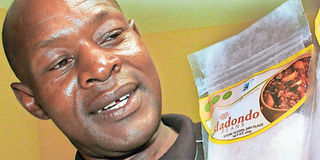New openings in pre-cooked beans

George Oketch, a beans farmer in Homabay, displays pre-cooked beans flour in an event in Machakos. Beans are not only one of the most important legumes in many global food systems but also a major staple food crop in Kenya. PHOTO | PIUS MAUNDU | NMG
What you need to know:
- Planting the beans starts with preparation of the land by a tractor or an oxen drawn plough.
- Healthy selected seeds are then planted in holes sunk using hoes at the onset of the rains.
- The Kenya Agricultural and Livestock Research Organisation (Kalro), Uganda’s National Agricultural Research Organisation, and Pan-Africa Bean Research Alliance are working to scale up the supply and use of pre-cooked bean products in the region for food, income and nutrition security.
- Joab Ouma, the director of Lasting Solutions, says his start-up up currently produces more than 100kg of pre-cooked bean products per day, which he supplies to supermarkets, schools and hospitals.
George Oketch’s farm in Wiga village, Homa Bay County, teems with five varieties of beans.
It is home to KAT B1, KAT B9, KAT 56, Rosecoco and Nyota varieties, which have been selected by researchers in Kenya and Uganda as raw materials for manufacturing pre-cooked beans because they cook faster.
“These varieties mature early and produce less gas in the stomach. They can also withstand the industrial rigours associated with the pre-cooking process,” Oketch explains as he takes the Seeds of Gold team on a tour of his six-acre farm.
The beans have become the new cash cow for farmers like Oketch, who grow, harvest and supply to the market, including to those who pre-cook them before selling.
The beans thrive in well-drained soils in areas that get moderate rainfall. Oketch plants each of the five varieties that are propagated through seeds on separate plots.
Planting the beans starts with preparation of the land by a tractor or an oxen drawn plough. Healthy selected seeds are then planted in holes sunk using hoes at the onset of the rains.
The seeds are planted one per hole, which is an inch or two at a spacing of 30 by 15cm. The beans can be intercropped with maize or sorghum to maximise space, says Oketch.
“The beans enrich soils through nitrogen fixation while the other crops provide them with shelter. In 2006, I started with a quarter acre. We had been interested in the beans by Caritas Kenya and Lasting Solution, a start-up based in Kisumu Town. The organisations assured us of a ready market for the beans,” he says.
Then, Oketch’s harvest was two 90kg bags of beans, which he sold to a farmers’ group whose members wanted to grow the new varieties. He earned Sh24,000 from the deal.
Currently, he farms the crop on 2.5 acres and harvests 15 90kg bags, which he sells to aggregators who make pre-cooked beans and snacks and farmers who buy them as seeds.
“I sell the beans to a value addition plant in Kisumu County. A kilo goes at Sh50 while fellow farmers buy a kilo of bean seeds at Sh100,” says the 44-year-old farmer, adding that the entry of the aggregators has stabilised the price of the produce.
BENEFITS OF THE BEANS
The Kenya Agricultural and Livestock Research Organisation (Kalro), Uganda’s National Agricultural Research Organisation, and Pan-Africa Bean Research Alliance are working to scale up the supply and use of pre-cooked bean products in the region for food, income and nutrition security.
The research organisations in conjunction with other partners such as the International Development Research Centre (IDRC) and the Australian Centre for International Agricultural Research (ACIAR) also seek to promote environmental conservation since a lot of charcoal and firewood is used in the cooking of raw beans.
Beans are not only one of the most important legumes in many global food systems but also a major staple food crop in Kenya.
So promising is the pre-cooked beans project that the Australian and Canadian governments have jointly committed to inject Sh1.9 billion into the project through ACIAR and IDRC, Dr Kathryn Toure, the latter’s regional director, said at a meeting in Machakos Town.
“The beans did very well in all the areas we introduced them. Farmers in Homa Bay, Makueni and Machakos counties are already growing the beans in large-scale,” said David Karanja, the head of the pre-cooked bean project at Kalro.
George Otiep, a Caritas Kenya official from Homa Bay, says with growing of the beans rising, they are foreseeing a situation where men will displace women in the bean value chain.
“If it happens, the problem would be that most of the crop would end up in the market, denying some families the main source of proteins,” he says.
Joab Ouma, the director of Lasting Solutions, says his start-up up currently produces more than 100kg of pre-cooked bean products per day, which he supplies to supermarkets, schools and hospitals.
The products are pre-cooked packaged beans that take less than 15 minutes for consumers to prepare, ready-to-eat bean snacks, and bean flour, which blends conventional flours for use in making ugali and chapati.





